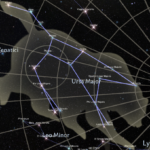The Constellation of Scorpius (‘Scorpio’) is a vast constellation visible from May to November in the evening sky of the Southern Hemisphere. It is located directly opposite the Constellation of Orion – therefore, visible when Orion is not.

Finding direction with the Constellation of Scorpius
Scorpio is commonly not used for determining directions, as due to its large size and the necessity to recognize some key stars, this constellation is not as user-friendly as others. On the other hand, it is a constellation that highly resembles the name it bears. The winding scorpion can be easily recognized in the night sky. When the Southern Cross is around its midnight position in mid-sky, the tail of Scorpio can be seen touching into the Milky Way.


Having found Scorpio, both pincers should be spotted. Before they divide into the pincers, a very conspicuous bright red star is visible. This is Antares, representing the upper body of the scorpion.
Looking down from Antares to the scorpion’s tail, another bright, blue star appears roughly the same distance as from Antares straight up to one of the pincer stars. I call this the ‘Highway’ from Antares to Epsilon Scorpii. The connecting line of this highway from Antares towards Epsilon Scorpii has to be extended until it touches the horizon, which is True North.
A widely known method of finding the direction of the South in the Southern Hemisphere is locating the Southern Cross, as described in this article on the website. The constellation of Orion is described here.
Lessons learned about finding direction with the Constellation of Scorpius
- Scorpio is seen from May to November only in the Southern Hemisphere.
- It is located directly opposite the constellation of Orion.
- The pincer- and winding-tail stars are conspicuous signs of this constellation.
- If you recognize the picture of Scorpio, it will be easily possible to see Antares.
- Drawing a line down from Antares along the ‘Highway’ to Epsilon Scorpii will directly lead to True North.
Further readings about Constellation of stars on this website:
Finding direction with the Constellation of Orion
Finding True South in the Southern Hemisphere
Finding direction with the Pole Star
.




